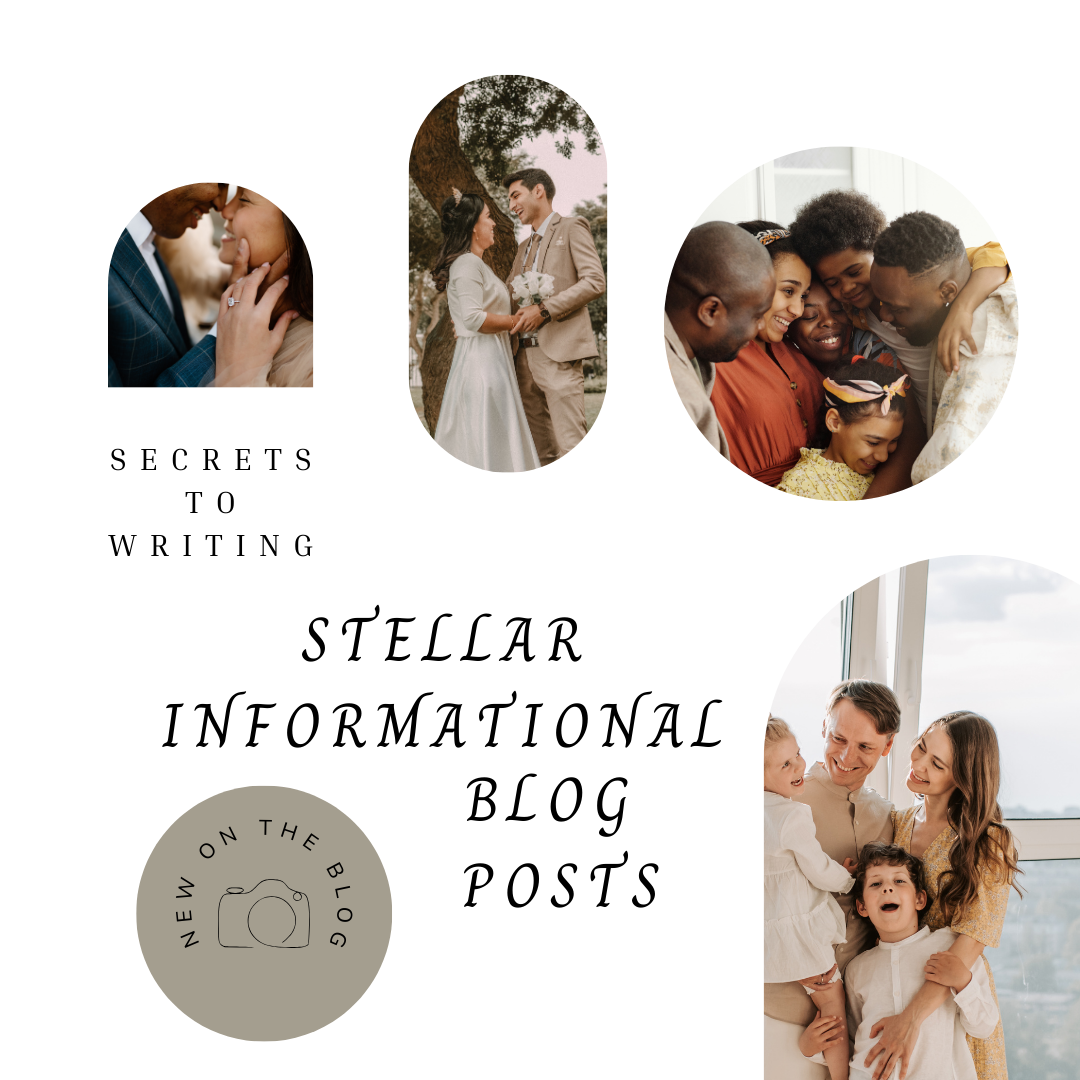In our last blog post we covered how to write up your photo sessions in a way that’s engaging for your readers and good for your SEO. But as a photographer, you should be blogging about more than just the sessions you’ve done.
“Hang on,” you might be thinking. “I’m a photographer. Sessions are what I do. What else is there to blog about?”
Plenty!
Today we’re going to talk about the informational blog post. We’ll cover:
- What an informational blog post is
- How to figure out your niche so you can write photography blog posts that speak to your ideal client
- What information to have at your fingertips so you can write outstanding informational posts that can serve you well for years.
What is an Informational Photography Blog Post?
I like to refer to well-written informational blog posts as power posts. (You’ll also hear them described as pillar content for your blog.) This is because they’re awesome for SEO, a great source of secondary keywords (see note if you’re not sure what a secondary keyword is) and they have a nice long shelf life. In other words, these high-quality posts may take more time and effort to write, but they will keep getting you results for months or even years to come.
Informational posts provide value to your clients by
- Answering questions
- Giving tips and advice
- Providing ideas and information
These types of blog posts also help you by establishing you as an expert in your field and creating a connection between you and potential clients—even when they’re not directly searching for your services.
*Note: Secondary keywords are words and phrases that you know your ideal client is interested in. These words and phrases relate to your business, but maybe indirectly. And because of that, they don’t lend themselves to optimization on the main pages of your site.
What Am I Supposed to Blog About as a Photographer If Not Sessions?
If all you’ve ever blogged is sessions, it can feel overwhelming to decide what else to blog about. Usually people either have next to zero ideas (“I guess I could do a post about my favorite newborn outfits…and…um…) or way too many (“I could share my favorite recipes, and a review of that awesome book I just read, and tips for DIY newborn photos, and a writeup of my vacation, and one about my new puppy…”)
In either case, it can be helpful to find a niche.
Ideally, a niche is something you know a lot about and that also overlaps nicely with your photography business. Here are a few examples:
If you’re a maternity and newborn photographer, maybe you could provide advice for new parents, or tips on how to take great DIY photos of little ones as they grow.
If you’re a wedding photographer, think about things like date night ideas, hair and makeup, relationship advice, etc.
Maybe you’re a photographer who also happens to be a wizard at digital organization. In that case, you might like to focus on guiding people through the process of keeping their photos and digital info organized and accessible.
As you brainstorm, think about your photography specialty, your personal life and interests, and the interests of your ideal client. Chances are, there’s an intersect in there somewhere that’s just begging to be turned into your photography niche!
But Why Is Having a Niche Important?
Okay, that’s great. But what’s the point? If you want people to come to you for professional newborn photos rather than going the DIY route, why would you write a blog full of helpful tips on how to take better baby pictures at home?
Having a niche helps your ideal client find you—even if they’re not specifically looking for you. Maybe your ideal client is looking for baby shower ideas. You don’t do baby showers…but you do baby pictures! And very soon, she’s going to be in the market for a newborn photographer. So how do you let her know you exist before she even starts thinking about a photoshoot?
You write a blog post about what she needs right now. You give her what she’s looking for, which is ideas for a baby shower. Do your job right and she will come across that blog post. All of a sudden, she knows you exist, she knows you provided her with helpful ideas, she knows what you do, and she has a new item to add to her baby wish list: professional newborn photos with you!
All right, it doesn’t always work that smoothly in real life. But you get the picture. By meeting your ideal client where they’re at right now, they’re much more likely to find out about you and your services, and to explore your business further when they need it.
Also, if you’re worried about shooting yourself in the foot (like providing someone with DIY photo tips when you want them to come to you), remember that if they want to find that information, they are going to find it. Google makes it easy. Better it come from you than from your competition. That way, they’ll learn your business name, be able to compare decent DIY photos to amazing professional photos from your studio, and have a positive interaction with your business.
What Do You Need to Write an Outstanding Informational Blog Post for Your Photography Blog?
So, now that you have a few ideas of what else you can write about besides sessions, how do you actually do it? What elements do you need to write stellar photography blog posts that go beyond describing what you do and actually provide help and answers to your readers?
So glad you asked!
Topic
First and foremost, you need to know what you’re writing about! When choosing a topic, remember to focus on how that topic is going to be helpful for your ideal client. You may have something you would love to share with people, but if it doesn’t help your reader, it’s probably not the best fit for your blog.
Also, keeping things general is fine when you’re just brainstorming. But when it comes time to sit down and write, get as specific as you can. For example, rather than writing a general post about how to take great maternity pictures, zero in on what you really want to share with readers. For example, “10 Simple Steps to Look and Feel Amazing for Your Maternity Photoshoot,” or “5 Best Poses for DIY At-Home Maternity Photos.”
As you can see, getting specific with your topic can help when it comes to figuring out a good title for your blog post too! It’s a lot easier to craft a compelling title when you know exactly what you’re covering.
Outline
Facing a blank page is one of those dreaded moments in your blogging life. And once you get going, it’s easy to get sidetracked and start rambling. To avoid both of these scenarios, it helps to have a loose outline so that you know exactly what you want to cover in your post. It doesn’t matter if this takes the form of a few bullet points, a detailed outline, or even a rough draft—just get your main points down on paper so you can get started easily and stay on track from beginning to end.
Keywords
The point of your informational blog post is to provide value for your clients. But keywords are how they find you, so it’s important to use the right words and phrases throughout your post.
While it’s not a good idea to optimize your blog posts for your primary keywords (you don’t want to cannibalize your main pages), it is a good idea to use those primary keywords throughout your blog post where they make sense. And of course, your blog is the perfect place to optimize for your secondary keywords.
Links and Resources
Links are important in helping readers find out more about a subject you mention in your post. This may mean linking to another page on your site (internal link), or it may mean linking to an outside source (external link). Always give credit where it’s due if you draw on someone else’s work to help you write your post!
Bonus points if you also include other resources that people can view or download. A pdf guide or brief video makes your blog post richer and more engaging for readers. While this certainly isn’t a make-or-break scenario, resources like these included in some of your high-power posts can make them even more helpful and successful.
Photos
Of course, you’ll want to include some photos. This is a photography blog, after all!
It’s okay if you don’t have photos in your library that directly relate to the topic you’re writing about. For example, if you are a wedding and engagement photographer and decide to write about romantic date night ideas in your area, you might just include some photos of couples from past sessions. You don’t have to have photos of all the restaurants you recommend (although links to them would be good).
And don’t forget to include alt text in your photos, especially if you can easily work your keywords into them.
An Understanding of SEO
My golden rule of blogging is: Write for your reader. But part of writing for your reader also means helping them to find you when they need you. While keywords and quality content may be the two biggest factors in writing a great photography blog post, there are many other SEO details that will help get your post noticed.
You can check out this blog post for more information about how to make your photography blog more SEO-friendly, but here’s a quick checklist that should cover the basics as you get started:
- Mix up your main keyword with synonyms. Don’t fall into the trap of keyword stuffing!
- Make sure your blog post title is accurate and compelling.
- Add alt text to each of your images.
- If possible, ensure that the file names of any photos or downloads reflect the subject of your blog post.
- Write a meta description for search engines to display under the title of your post.
- If your post is long, consider adding a table of contents at the top so readers can skip to the parts of your article they’re most interested in.
The Answer to the Big Question: How Does This Relate to My Ideal Client?
Last, but certainly not least, you’ll need the answer to the big question: How does this relate to my ideal client? Why is it of value to them? And am I doing a good job of meeting their needs with this blog post?
If you have a solid answer to the big question of how your post relates to your ideal client, then you have the core of a successful photography blog post. The rest is just details!
In Conclusion
Informational photography blog posts can be hugely helpful for boosting your SEO and building relationships with potential clients. Even if you decide that you want the majority of your blog posts to be session-oriented, I highly recommend including informational posts on your blog as well.
This type of pillar content provides benefits that shorter session posts just can’t deliver. Plus, while session posts become outdated quickly, informational posts are evergreen content that just get better with age.
Yes, high-quality evergreen blog content is time-consuming to write and it takes effort and know-how. But as you get more comfortable with these secrets to writing stellar informational blog posts for your photography blog, you’ll find that it’s well worth it to have blog posts that keep delivering results for months or even years after you’ve published them.
If you’d rather have someone else take care of standout pillar content for your blog, please get in touch! I would be delighted to discuss your blogging goals and truly honored if you choose to trust RedFox Blogging with this important aspect of your business.
Keep Exploring
Other blog posts you might love:



